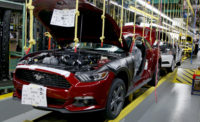Automotive Industry
Ford Assembly Plants Use Carparks to Generate Electricity

DEARBORN, MI—Ford Motor Co.’s assembly plants in South Africa and Thailand get a significant portion of their electricity from solar panels mounted to canopies in parking lots.
“Solar canopy carparks are an incredibly exciting opportunity for Ford as they allow us to make use of spaces that would otherwise have limited use,” said Andrea Cavallaro, director of operations at Ford’s International Market Group. “They provide shelter for finished vehicles from the rain and excessive heat, while also providing power for nearby facilities.”
At Ford’s Silverton Assembly Plant in Pretoria, a 13.5-megawatt solar carport with parking for more than 3,500 vehicles was completed in 2022 and now contributes 18 percent of the electricity needed to produce each Ranger. This means more than 20,800 Rangers per year can be assembled using power generated by the sun.
Similarly, at Ford Thailand Manufacturing (FTM), a 7.7-megawatt solar carport has recently been switched on, providing shelter for more than 1,500 vehicles. The solar roof contributes to an annual reduction of more than 5,700 tons of CO2 emissions and contributes up to 20 percent of the energy needed to produce every Ranger and Ranger Raptor at the plant. To put that into perspective, around 21,000 vehicles can be built at FTM using solar power alone every year.
Auto Alliance Thailand announced plans to build an 8-megawatt floating solar energy array near its Rayong facility this year. The project is scheduled to go online in September and will offset more than 5,400 tons of CO2 emissions per year. This will supplement the 6-megawatt solar project the plant already has in operation, making AAT Ford’s largest user of solar energy in the region at 14 megawatts.
“At Ford, we’re focused on environmental quality; both in terms of what we build and how we build. We’ve continued to push ourselves to conserve water, reduce waste and transition to carbon-free electricity in manufacturing,” said Cavallaro.
Ford is working toward sourcing 100 percent carbon-free electricity for its global manufacturing facilities by 2035. The brand is well on its way, obtaining 70.5 percent of its electricity needs worldwide from carbon-free sources.Looking for a reprint of this article?
From high-res PDFs to custom plaques, order your copy today!




